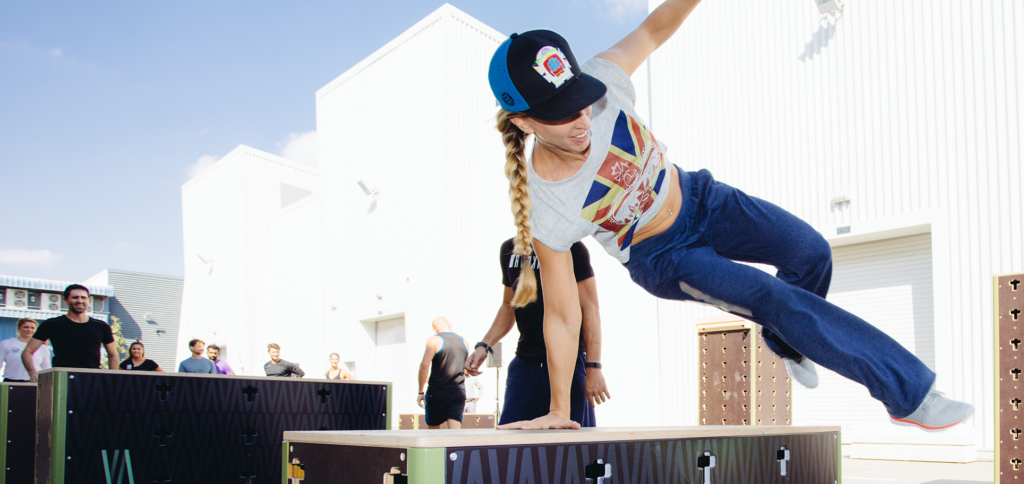I love movement, more specifically, I love full-body movement because I think it’s the most beneficial kind. And last week, I finally got to interview a pioneer in a full-body movement practice that is gaining a lot of traction worldwide these days: Parkour.
Here in Dubai, you may have already seen Parkour classes where adults and children climb, roll, jump, run, push and pull themselves over, under and around obstacles in a park or gym. They are tons of fun and can be as easy or challenging as you want. Sure, you could say that about many sports – but this one is different. Let me explain.
Because it requires people to train at moving freely and efficiently in all sorts of directions, they become a lot more body aware and their proprioception vastly improves. Essentially, it keeps the body, nervous system and mind young and constantly evolving. When you look at videos of well-seasoned practitioners, they make any movement look smooth, easy and natural, it looks like an art form. They are strong all over – unlike most athletes, no muscle is overdeveloped or underdeveloped – they are flexible, lithe, relaxed…and don’t suffer from chronic pain at 35. My youngest son has been doing this practice for over a year now and I am in awe of how much he has benefitted.
Anyway, back to my interview where I got to meet 2 amazing people: the head of Parkour.ae, Stephane Vigroux – who also happens to be one of the founding fathers of the sport – as well as one of his top trainers, Andrea Brooks. Enjoy the read!!
WM: What is the history of Parkour?
SV: It started in the suburbs of Paris, France where a group of friends who wanted to stay out of trouble would get together after school and would “play”. They were sporty but not involved in any organized sport per se. So they’d spend time looking at benches, poles, walls or buildings, wondering if they could crawl, roll, jump over or around them and try all sorts of things. A lot of it was about finding a way to move through an urban environment with curiosity and imagination. They would give themselves challenges and train before school, well into the night, etc. From there, it grew. More people started doing Parkour, the sport also started getting attention from the media. It was just around the time Youtube and social media were taking off and videos about it were going viral. For example, there was a documentary called Jump London, that brought some of the guys together to showcase their skills using London as their backdrop.
Today, Parkour has become a sport that is being taught and practiced all over the world.
WM: How old or young do you have to be to do Parkour and how dangerous is it?
AB: There are a lot of myths around Parkour; many people assume it is for teenagers or people who like extreme sport and want to get an adrenaline rush. In actual fact though, it’s a very personal practice and different individuals do it for different reasons. 80% of people who practice with us here in Dubai are kids but in the UK, it is 80% adults. It depends on people and how they want to work out. We offer classes from age 2 to adults. We have parent-child classes for 2-year olds, then the core is our Youth Academy, from age 3 to 17, and we of course offer adult classes.
As for the danger aspect, I don’t think it’s an issue. More people get injured through football!
SV: Of course, you don’t start by jumping off a roof – you first develop abilities on the ground level, build a potential and eventually take on bigger challenges. In our classes, we simply encourage people move their bodies through space and confront obstacles – a kind of obstacle course really. When I started Parkour at 18, I remember my parents and family were scared I’d get hurt and injured. Ironically, a lot of them had hip, knee and spine problems. Today, I don’t have any of that because I have always kept moving.
WM: What is the structure of a typical class?
AB: Initially, classes take place in one of our gyms. A typical class has a warm up – the goal is to wake up your mind and muscles, joints – it can be a game or a balance challenge. Then there is the technical part of the class; every 2 weeks we will rotate between different concept or techniques. At the end of class we do a mobility or conditioning challenge before we stretch a little bit. The goal in each class is to string the movements together the same way you would in a dance class so that people can achieve their objective. Technically, we try not to be too stringent, especially for kids. Our specialized adult classes are more boot camp style, where the goal is to prepare you for the type of conditioning you need for Parkour. Instead of regular burpees for example, you do them with extra challenges or obstacles, like a box or something.
WM: How accessible is it to kids or adults who are new to it?
SV: Anybody can start Parkour, regardless their experience because it provides so many moments for people feel accomplished. It has nothing to do with points or competition, it’s just them and the obstacles they want to overcome. Everybody is so focused on figuring out what they are doing that they don’t have time to look at what others are thinking. In fact, the philosophy we encourage is to be humble and help each other.
WM: What advice would you give to Parkour first-timers?
AB: Don’t be too hard on yourself and leave your ego at the door. A common mistake adults make is to expect themselves to do what they used to do when they were 20. Some still think they need to do at a certain level for it to count as a proper workout. It is about starting at a level that is yours today and finding the joy in moving, not about hurting yourself. Another thing we see a lot are people who think they aren’t in good enough shape to do it – and think they have to train in order try Parkour. In reality, they just need to get started and get over any sort of ideal of what they should be doing.
WM: Can you discuss the fear aspect?
SV: Our bodies want to move in all sorts of ways, they are designed to move. As we grow older however, we move less, we “behave”, we stop jumping, leaping or playing because it “isn’t for us anymore”. We are basically told to stay in a box, and this is when fear and inhibitions start settling into your mind. That’s why we lose a lot of our agility as adults: lack of practice and the fear it ensues. With Parkour, you need to face challenges and as you get engaged with a task, you might be a bit afraid, you don’t know what the outcome will be, you try, explore, discover and eventually, you get there. You relearn how to move and develop further skills. That whole process is a powerful tool for confidence building.
WM: What are some of the reasons people do Parkour?
SV: Overall, people who come are looking to improve their wellbeing in some way.
Some focus on the physical benefits of it – how it develops body awareness, coordination, strength, flexibility, etc – while others see it as an art form where they can express themselves through space with their body. Another interesting facet of Parkour is how it develops the mind: it teaches you commitment, confidence, discipline, self-improvement, how to overcome your fears, etc.
WM: Can you discuss some of the mind benefits?
SV: There are so many. Parkour is like meditation in motion. You are immersed in a task and there is no room to worry or think about what you are going to do tonight, what you should have done today or anything else. There is a reality that you are balancing on something and if you aren’t present in the moment you can mess up and fall, etc. You have to engage – and that is great. These days, a lot of people are looking for that.
AB: Parkour is also a great creative outlet. You are constantly using your imagination and creativity to find all the different ways you can move. Another thing I love is the fact that you have to make it happen with your body. It is about owning your body. It teaches you how to move through real life consequences. When you do more structured forms of exercise, you are told what to do and how to do it – the exact pose, movement or technique. In Parkour, it’s very different: you have objectives like jumping here or crawling there and it’s your responsibility to figure out how you are going to do it. It’s all about trial, error and the feedback your own body gives you. It’s a very empowering learning process.
WM: Why are kids so attracted by the sport?
The thing is, children are powered by the “here and now” and Parkour is all about that. Also, it isn’t as structured, so it might seem more fun for them. And you have to remember that kids don’t have the hang ups that many adults do with regards to getting raw and physical, the fear aspect or even the social image, etc.
WM: How often should you practice to improve?
The more you practice the better you get at it obviously but it depends what your objective is. If you are honest with your goal then you need to put the time and effort in. Generally, 2/3 times a week is a good pace.
We also encourage people to train on their own – the whole point of Parkour is to do it anywhere. You might see a bench, a Parkour student will see movement possibilities, you see a pole, they will see something to climb. We give them exposure, knowledge and guidance here in our gyms but then quickly encourage them to go outside. We give outdoor classes at Umm Suqeim Park and teach them how to use outdoor props.
For more information:
Parkour DXB – Courses and registration
Website: http://www.parkour.ae/
Instagram: https://www.instagram.com/parkourdxb/
Email: info@parkour.ae
Phone: 800 PARKOUR
Address: Warehouse 42, Alserkal Avenue, Al Quoz 1, Dubai

Stephane Vigroux
To see some videos and get useful info, visit Stephane’s FB page and Instagram

Andrea Brooks
Get some Parkour inspo visit Andrea’s Instagram




